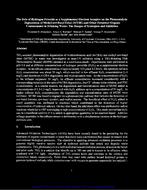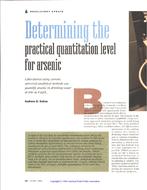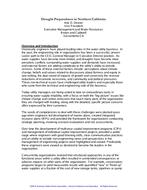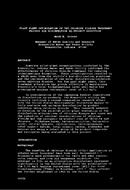Provide PDF Format
AWWA ACE54345
- The Role of Hydrogen Peroxide as a Supplemental Electron Acceptor on the Photocatalytic Degradation of Methyl tert-Butyl Ether (MTBE) and Other Persistent Organic Contaminants in Drinking Water: The Ranges of Synergism and Inhibition
- Conference Proceeding by American Water Works Association, 06/01/2001
- Publisher: AWWA
$12.00$24.00
Titanium dioxide (TiO2)-assisted photocatalytic degradation of 4-chlorobenzoic acid (4-CBA) and methyl tert-butyl ether (MTBE) in water was investigated at near-ultraviolet (UV) radiation using a TiO2-rotating disk photocatalytic reactor(RDPR) operated in a continuous mode. Experiments were performed at pH=3.0 and at different concentrations of hydrogen peroxide (H2O2) as a supplemental electron acceptor. At an influent concentration of approximately 310 umol 4-CBA/L, theoptimum influent H2O2 concentration was about 50 mg/L which resulted in low effluent H2O2 concentrations and maximum 4-CBA degradation and mineralization rates. As the concentrations of H2O2 in the influent surpassed 50 mg/L, itseffluent concentration increased considerably with a corresponding reduction in the rates of 4-CBA degradation, free Cl- release in the solution, and total organic carbon (TOC) mineralization. In a similar manner, the degradation and mineralization rates of MTBE added in concentrations of 1.3-1.5 mg/L improved with H2O2 addition up to a concentration of 50 mg/L. At higher influent H2O2 concentrations, the degradation and mineralization rates of MTBE were inhibited. MTBE was found to degrade via a photocatalytic pathway that includes the formation of tert-butyl formate, tert-butyl alcohol, and methyl acetate. Thebeneficial effect of H2O2 added in small quantities was attributed to reactions which contributed to the formation of higher concentrations of hydroxyl radicals. On the other hand, the inhibition effect was attributed to radical reactions which lead to hyroxyl radical scavenging at high concentrations of H2O2. This study proved that H2O2 can be a beneficial additive if it is added in appropriate quantities in the reaction liquid. Addition of large quantities in the influent stream is detrimental with a simultaneous increase in the hydrogen peroxide cost. Includes 19 references, tables, figures.
Related Products
AWWA JAW36110
Journal AWWA - Determining the Practical Quantitation Level for Arsenic..
$15.00 $30.00
AWWA ACE91058
Pilot Plant Optimization of the Chlorine Dioxide Treatment Process for Disinfection By-Product Redu..
$12.00 $24.00
AWWA WSC70057
Forming Collaborative Partnerships to Advance Water Security: The TEVA-SPOT Story and What Is Still ..
$12.00 $24.00





